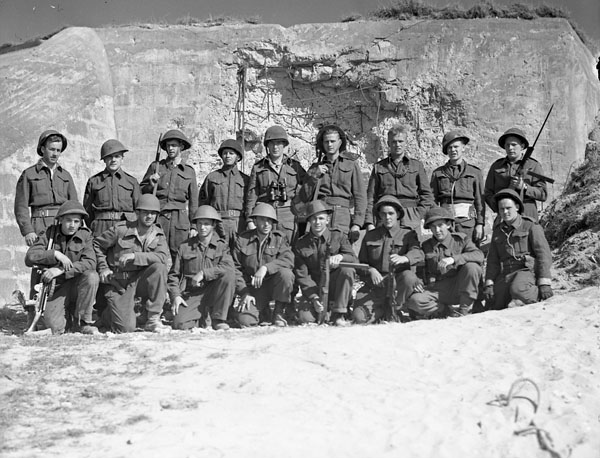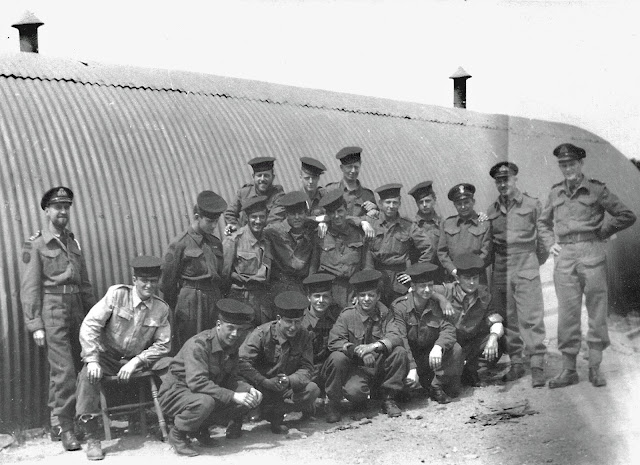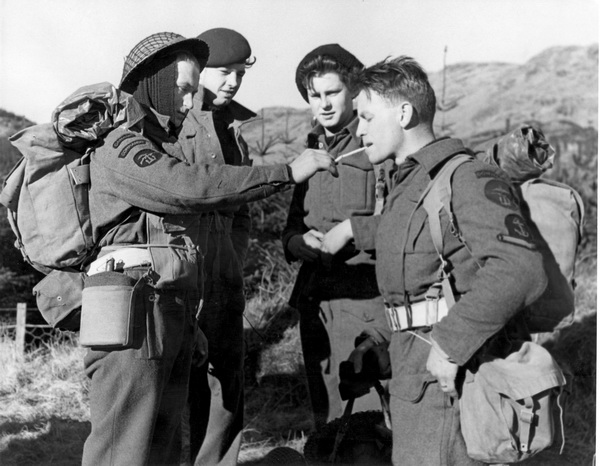Some Not So Good News Too for New Recruits
Canadians Ray Ward and Jim Cole at HMS Quebec, Inveraray Scotland
At Combined Operations No. 1 Training Centre. Photo - Joe Spencer
Canadian members of the Effingham Division (RCNVR out of Halifax) arrived in Scotland's No. 1 Comb. Ops training centre in early spring, 1942, after some initial training related to landing crafts in southern England, at HMS Northney on Hayling Island. Though I am not aware of their exact timeline, they spent time at Camp Auchengate as well (between Irvine and Troon), in preparation for their first call to action.
Unbeknownst to the sailors, they would be called upon to participate in Operation RUTTER, which was cancelled before the day of departure, and later in Operation JUBILEE, both in the summer of 1942.
While training they would have had access to local newspapers and more than one story would have fostered discussion, concerns and possibly the occasional smile amongst the young Canadians.
From The Irvine and Fullarton Times (February 27, 1942):
GOOD AND NOT SO GOOD
Although the Allied nations have a long and rough road to travel ere they attain the aim they are determinedly setting out for in the Far East - superiority of forces and equipment - they have begun at least to hit hard blows on the enemy. These blows, temporarily crippling to the enemy though they are, cannot be expected to wholly check him in his conquering sweep through the Pacific or towards India. But they are telling factors in that wearing down process which constitutes our essential strategy at present and will continue to constitute it for a considerable time.
It must be admitted that the war pictures being flashed day by day from the Far East zone are, on the whole, the reverse of heartening. India is being still more gravely threatened, Java and island after island in the Pacific are in dire danger of coming under enemy control, and even Australia has had its first taste of Japanese aggression.
The Japanese have not, of course, been allowed to maintain their pre-arranged timetable, but they are gradually working out their widespread and cleverly designed plan of campaign, and at the moment there seems little prospect of their being halted definitely. The Allied forces can only defend with desperation as long as defence is possible, and patiently await the assured day when the tide of aggression will turn, and hope that that day will come before too much is lost.
The Soviet Roller
Russia still provides us with the bright news of the war. Despite desperate German counter-measures that are using up valuable enemy reserves, the Soviet roller is still relentlessly moving on. The Russian attack is developing on five fronts, but the most important for the present is the Leningrad front.
At Stavaya Russa the German 16th Army has been encircled, and has lost 12,000 in killed and a huge amount of booty. This is an outstanding victory for the Soviet forces, and it gives them control of the most vital section of the Leningrad front and allows them to threaten one of the lines of supply of the enemy armies besieging Leningrad. Above all, it is only the first stage of a big offensive about to be carried through, and important fresh successes are said to be imminent.
This good news from Russia should be a fresh incentive to us to provide all the material help we can for our Ally's brave forces, while the not so good news from other parts should likewise prove an impetus to the workers of the nation to put full strength into their effort.
We have had some staggering blows to our national pride recently, and more are yet to be suffered. But if these blows serve to awaken us to our weaknesses and inspire us to remedy these weaknesses, they will have served a great purpose. And, knowing the heart and will and sinews of our nation, who can doubt that that purpose will be served?
Two ads from The Irvine and Fullarton Times, February 27, 1942
* * * * *
In the article above we read "this good news from Russia should be a fresh incentive to us to provide all the material help we can for our Ally's brave forces." And the "not so good news" should impel workers "to put full strength into their effort".
Citizens and workers, at least in Allied countries, were continually encouraged during WW2 to do what they could, give what they could, be it by way of buying Victory Bonds, cultivating a Victory Garden or giving pennies to the Red Cross or nickels here and dimes there. Or pounds. lots of pounds, as seen below:
Heavy headline (in Pounds) in The Irvine and Fullarton Times, April 3, 1942
The accompanying article reads as follows:
After opening in a manner that alarmed many of our leading citizens by disappointing figures of the first day's operations, Irvine's Warship Week astonished not only the citizens of our town but also those of surrounding districts by the enthusiastic success of its concluding stages.
On the opening day, Saturday, 21st March, the sum raised was considerably under five thousand pounds, and had the money-raising pace continued during the whole week at this rate, the effort would have produced less than half of the target figure of 80,000 Pounds aimed at.... the last four days of the week all had five-figure totals, and the concluding day, Saturday last, raised 23,847Pds. 19s 10.5d, which is 731Pds. 14s 10.5d more than the highest total reached on any one day of Irvine's War Weapons Week in June of last year.
The following table shows the sums raised on each day of Irvine's Warship Week and the sums raised on the corresponding days of the burgh's War Weapons Week in June last:
Photo of The Irvine and Fullarton Times, April 3, 1942
(As found on microfiche at Saltcoats Heritage Centre)
A celebratory pageant followed the fundraising week:
The Pageant
The pageant, which had originally been arranged to take place on the opening Saturday of the burgh's Warship Week, had to be postponed until the following Saturday, the closing day of the campaign, on account of difficulty in obtaining an adequate supply of pipe and brass bands on the former date, and Saturday last, with its pageant and its record-breaking total of money raised on that day, providing a fitting culmination to one of the most memorable weeks in the history of our town....
The turnout of units of H.M. Forces, which rightly occupied the place of honour in the leading section of the parade were impressive, both on account of their smartness and precision on the march and on account of their numerical strength. The strength and number of different units was much greater that at War Weapons Week procession nine months ago, and their presence undoubtedly did much to tone up the whole turnout....
An excellent impression was created on the spectators as soon as the head of the procession came into view.... (many detachments followed) and Irvine A.T.C., under Rector James Porter, followed, and completed this section of one of the most memorable spectacles the old burgh has witnessed for many years....
Many thousands of spectators lined every section of the route, and at some of the principal points, such as Bridgegate Head, the crowds flocking over pavement and roadway as soon as the rear unit of the procession has passed, made progress along the streets almost impossible. The procession had five bands in its ranks and was about a mile long....
Of this sum (i.e., 55Pds. collected on route) the Boy Scouts secured 1Pd. 6s in a rather involuntary manner. They were not part of the collecting brigade but on their vehicle they had, as part of their equipment, a very large open box, and so keen were many of the spectators to give their contribution that cash to the amount of twenty-six shillings was thrown from the crowds into the box....
As found in The Irvine and Fullarton Times, Sept. 4, 1942
Art Warrick (Hamilton), Canadian in Combined Ops at HMS Quebec, 1942
From the collection of Joe Spencer, used with permission





























